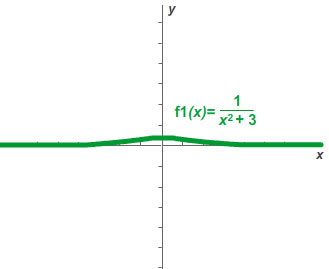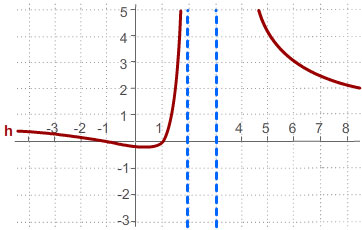
As experienced in the first section, when graphing rational functions, you will encounter instances where the function cannot be defined.
What reason can you think of that may cause this to occur?

![]() Click on the image below to access the applet. The applet below will allow you to explore vertical asymptotes of graphs of rational equations using sliders.
Click on the image below to access the applet. The applet below will allow you to explore vertical asymptotes of graphs of rational equations using sliders.
Use the sliders to change the value of a and b in the function, x squared over (x + a)(x + b) x2 (x + a)(x + b) . As you do so, notice how the vertical asymptotes are defined and how you might be able to find them given any rational function. Use the applet to complete the table below, and use your table to answer the conclusion questions that follow.
| Values of a and b | Equations of Vertical Asymptotes |
| a = 3 b = -2 |
|
| a = -5 b = 7 |
|
| a = -6 b = 4 |
|
| a = 6 b = -5 |
| Values of a and b | Equations of Vertical Asymptotes |
| a = 3 b = -2 |
x = -3 x = 2 |
| a = -5 b = 7 |
x = 5 x = -7 |
| a = -6 b = 4 |
x = 6 x = -4 |
| a = 6 b = -5 |
x = -6 x = 5 |

Each time you changed the value of a or b, a vertical asymptote appeared on the graph telling you that the function could not be defined at that value of x. How could you find the equation of the vertical asymptote algebraically?

From the applet, if you have a value of a = 3, then what did that mean for the factor of the denominator and the corresponding vertical asymptote?

The denominator of the rational function will give you the vertical asymptotes. Will there be rational functions that do not have vertical asymptotes or holes?
Since a rational function is a ratio of two polynomials, the polynomial in the denominator will tell you if there is a vertical asymptote. Yet, in some cases, there will not be a vertical asymptote. For example, in h(x) = 1 over x squared + 3 1 x2 + 3 . When you set the denominator equal to zero and solve, you get an imaginary value for x. There is no value of x when substituted into the function that will cause the denominator to be zero and make the function undefined. The graph of this function is shown below.


When you are finding vertical asymptotes, you use the denominator of the function. Why is it important to also use the numerator in finding vertical asymptotes?
1. Given the graph of the rational function below, what is the polynomial that represents the denominator?



2. Identify the vertical asymptotes for the following function.
g(x) = 7x squared + 10x - 62 over x squared + 2x + 1 7x2 + 10x − 62 x2 + 2x + 1

3. Which of the following statements are true regarding the rational function:
f(x) = x cubed + 7x squared + 12x over x cubed - 16x x3 + 7x2 + 12x x3 − 16x
I. There is no vertical asymptote for f(x).
II. There is a vertical asymptote at x = 4.
III. There is a hole in the graph at x = -4.
IV. There is a hole in the graph at x = 0.